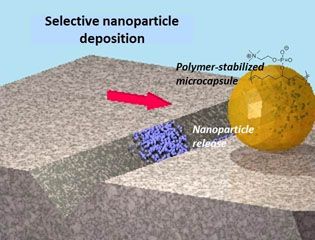 Facile methods for detecting and repairing damaged regions of materials are critically important in numerous structural and functional materials, from airplane wings to fabrics to microelectronics to biological implant materials. Emrick, Crosby, and Russell, working in the Materials Research Science and Engineering Center (MRSEC) on Polymers at UMass Amherst, demonstrated that microcapsules can carry nanoparticles across a damaged substrate, sense the damaged regions, and deposit nanoparticles selectively into the damaged areas, leaving the rest of the surface unaffected. The work represents an experimental realization of a theoretical challenge described by Balazs (U Pittsburgh), termed “repair-and-go”. The success of “repair-and-go” hinges on microencapsulation with polymer surfactants, as the thin polymer capsule wall (the polymer structure of the capsules is shown in the figure) allows nanoparticles to pass out of the capsule and into the crack. Moreover, the polymer is anti-fouling, preventing irreversible absorption of the capsule on the substrate or in the damaged region.
Facile methods for detecting and repairing damaged regions of materials are critically important in numerous structural and functional materials, from airplane wings to fabrics to microelectronics to biological implant materials. Emrick, Crosby, and Russell, working in the Materials Research Science and Engineering Center (MRSEC) on Polymers at UMass Amherst, demonstrated that microcapsules can carry nanoparticles across a damaged substrate, sense the damaged regions, and deposit nanoparticles selectively into the damaged areas, leaving the rest of the surface unaffected. The work represents an experimental realization of a theoretical challenge described by Balazs (U Pittsburgh), termed “repair-and-go”. The success of “repair-and-go” hinges on microencapsulation with polymer surfactants, as the thin polymer capsule wall (the polymer structure of the capsules is shown in the figure) allows nanoparticles to pass out of the capsule and into the crack. Moreover, the polymer is anti-fouling, preventing irreversible absorption of the capsule on the substrate or in the damaged region.


